Sponsored Post: Experience the difference! Visit Notre Dame's Open House


A new partnership with the Batavia Career and Technical Education Center (BOCES) and Cornell University is paving the way for students interested in a career in precision machining.
The unique program, which is the only such partnership in the nation, allows students to study realistic particle accelerator hardware designs and fabricate hardware based on those designs, said Maggie Fitzgibbon, head of public relations at Genesee Valley Educational Partnership.
“Within the next several years, the Cornell-BNL Energy Recovery Linacs Test Accelerator at the Cornell Laboratory for Accelerator-based Sciences and Education (CLASSE) will develop into a powerhouse of accelerator physics and technology and will be one of the most advanced in the world,” said Lora K. Gruber-Hine, director of Education and Outreach Programs at the Cornell laboratory.
“The building of ERL will require the cultivation of local talent and a highly trained workforce. When this prototype ERL is complete and expanded upon, it will be a critical resource to New York State, the nation and the world, propelling science, biomedical advancement and economic development.”
Tim Gleba, precision machining instructor, was instrumental in development of the new partnership. After watching a video on the Cornell High Energy Synchrotron Source Facebook page explaining how machinists work to create parts for the particle accelerator at Cornell, he was intrigued and thought this could possibly be a project for his students.
He pitched his idea to Cornell and a meeting last summer resulted in development of a project plan for this school year.
Batavia CTE’s precision machining students are now creating 150 parts for Cornell’s particle accelerator. These include adjustment plates and brackets, as well as a short dipole spacer bar. These parts are used to align magnets within a tolerance of .004 inches, Gleba said.
“This partnership is a wonderful opportunity for these high school students,” Gleba said. “They are able to work with Cornell’s engineers, physicists and machinists.”
Development of the partnership adds a whole inventive aspect to the precision machining curriculum and provides students with relevant work experience, Gleba added.
“Our machine shop and Cornell’s are virtually the same,” he said. “Cornell has the identical machines as us and also uses the same software as what we have in our Precision Machine Shop here in Batavia.”
Students recently toured the Wilson Synchrotron Laboratory at Cornell to kick off the new partnership, according to Fitzgibbon.
Gruber-Hine said they want to showcase the partnership and the new technologies being developed.
She and Gleba both commented on the shortage of trained employees in the precision-machining industry.
“Our lab has been sensitized to the shortage, and as we are growing, the need for skilled labor becomes more evident," Gruber-Hine said. “We realize the need to cultivate a relationship with institutions that train skilled professionals to fill this middle skills gap. When Tim watched our video, he wanted to form a relationship with our laboratory that would allow his students to work on meaningful machining products and contribute to the work being done here.”
“Within the next five years, it is anticipated 50 percent of the precision machining workforce will be retiring, leaving an incredible gap,” Gleba said.
The Precision Machining class at Batavia BOCES had been discontinued for several years, after longtime instructor David O’Geen retired, Fitzgibbon said. But when several high school students expressed an interest in the field, Gleba was hired three years ago in an effort to resurrect the program.
Four of those students are Ayden Odachowski, James Roggow, Benjamin LaBombard and Evan Bartz.
Bartz said he wanted to get into machining because he knew the field was exploding.
Bartz and Roggow worked together to create a process to machine both sides of spacer bars.
Jon Sanfratello, executive principal of the Batavia campus, which includes the Batavia CTE Center, commented on how this partnership provides students with the chance to learn advanced manufacturing skills. The Precision Machining Program is currently affiliated with the National Aeronautics and Space Administration’s HUNCH program. Along with manufacturing hardware for Space X-10, students learn how to inspect and analyze the parts to meet the expert standards set forth by NASA.
“We pride ourselves in offering innovative programs that give our students real-world applicable learning opportunities,” Sanfratello said. “In this new partnership with CLASSE, our students will study cutting-edge designs, learn modern manufacturing methods so they are equipped to succeed in the 21st century workforce.”
“The goal of this partnership is to inspire the next generation of machinists and trades professionals by providing educational opportunities for students to work in concert with engineers and technical directors,” Gruber-Hine added.
Top photo: Tim Gleba, right, instructor in the Precision Machining Program at Batavia Career and Technical Education Center, and student James Roggow show some of the parts the class is making for the particle accelerator at Cornell University.
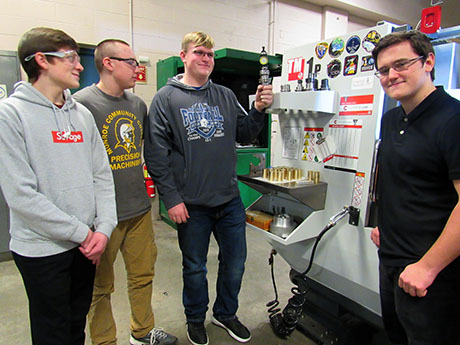
Above, four of the students in the Precision Machining Program at Batavia Career and Technical Education Center are, from left, Ayden Odachowski, James Roggow, Benjaming LaBombard and Evan Bartz. The Center is engaged in a partnership with Cornell University’s lab to make parts for the college’s particle accelerator. This is the first such partnership in the nation with high school students.
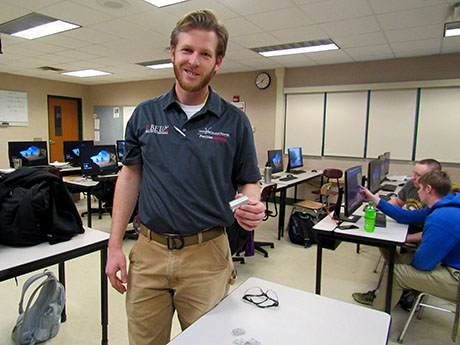
Tim Gleba, instructor in the Precision Machining program at the Batavia Career and Technical Education Center, holds one of parts made by high school students in his class in a one-of-a-kind partnership with Cornell University. Gleba was hired three years to train precision machinists, which are in dire need throughout the area. Gleba said Cornell and industry in the region will be looking to hire 100 precision machinists within the next five years.
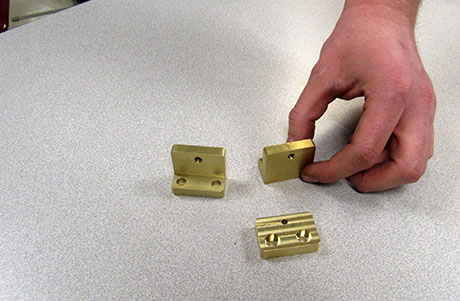
This is an example of the parts machined by students at the Batavia Career and Technical Education Center. The program was revived three years ago to train precision machinists for the industry.
Children at St. Joe's this morning had fun making their own slime. It was then judged based on consistency, texture and elasticity.
For readers using The Batavian's app, click here to view the video on thebatavian.com.
To celebrate the life of Martin Luther King Jr., the second-grade students of Anne Marie Starowitz at St. Joseph's School wrote essays about King. The essays were judged by Jennifer Corbelli, an English Language Arts teacher at Batavia High School.
First Place, Olivia Bezon
Dr. Martin Luther King Jr. wanted peace and love for all people. When Martin Luther King was little everything was different. That white people did not want the black people near them. Martin Luther wanted everybody to be happy but it never happened because white people bossed black people around. The white children got better things, the black people didn’t. White children had better schools. Black children had to go to black schools separate from the white children, this is called segregation.
Civil rights mean black people and white people have to learn to love each other. Protesting is when you have a sign with you and use your words to say what you want. That means protesting without fighting. Rosa Parks was asked to move to the back of the bus because a white person wanted her seat. She was arrested. Dr. King heard about this and he decided to protest and his sign said don’t ride the bus until the black people could sit where ever they wanted. After one year of not riding the bus the law was changed.
Martin Luther is also famous for his speech I Have a Dream. He gave his famous speech in Washington, D.C. He said he didn’t want it in 10 years, he wanted equality now. He didn’t want people to fight or to hurt anybody because Dr. King didn’t believe in fighting. Civil rights mean black and white people have the same rights.
Dr. King was shot and everyone was sad and everything got better because of him. Dr. King will be remembered for his speeches and his peaceful nonviolence protest.
Second Place, Matthew McCulley
Doctor Martin Luther King Jr. was a civil rights leader. He was born in Atlanta, Georgia in 1929. He learned in his childhood to never fight. He believed in nonviolence. Nonviolence is marching to the principles of nonviolence. Dr. King had 10 Principles of Nonviolence. They are like our 10 Commandments because they are both about being good. He wanted equal rights for everyone. Nonviolence is not fighting. The Jim Crow laws are when Rosa Parks, had to move to the back of the bus. Protesting is when people hold signs if they are mad. When you dislike someone that is called prejudice.
Martin had to sit in the balcony of the movie theater. Martin Luther was sad he couldn’t play with his white friends. In the movie The Boy King, white people did not like black people. Dr. Martin Luther King Jr. gave a speech in Washington, D.C. It was called the I Have a Dream speech. His speech was about equal rights. Dr. King didn’t want white and black people to be separated. That is called segregation. If someone is fighting say don’t fight. If someone is bullying someone you can say stop.
In 1968, in Memphis, Tennessee Dr. King was shot. On January 15th we celebrate Dr. Martin Luther King’s Jr. Birthday.
Third Place, Chelsea Fitch
Doctor Martin Luther King Junior was a civil rights leader. Martin Luther didn’t like prejudice and he didn’t like segregation. When Martin was a little boy, he couldn’t play with his white friends because white and black children could not play together. They could not use the same bathrooms or drinking fountains. When Martin was little he wanted everyone to be friends. Martin knew he liked books even before he could read. When he grew up he went to a dance and his grandma died. Martin was so sad because he promised his grandma he would be back.
Martin Luther King Jr. believed in nonviolence. Rosa Parks wasn’t going to give up her seat and Martin agreed with Rosa. Martin told all black people not to ride the bus, this was a peaceful protest and it was called a bus boycott. The law was changed. He led many protests because he wanted the laws to change so it would be equal rights for the blacks. People would have signs and they would all walk together without fighting back. That is nonviolence. Nonviolence is also about when people don’t fight each other because of the color of their skin.
Martin gave many speeches. He died. He always believed do not fight back with violence, do not protest with violence. Do what is right and not wrong. Help people. Don’t say God’s name in vain. Treat people the way you want to be treated. Help people with kindness. People followed Dr. King’s coffin down the street.
We celebrate the life of Dr. Martin Luther King Jr. every January 15th. That was the day he was born. It is a national holiday, it means everyone in the United States celebrates his day.
Honorable Mention, Eddie Lankford
Dr. Martin Luther King Jr. had a dream. He wanted people with white skin and black skin to get along.
People with black skin had to sit in the balcony at a movie theater. Martin Luther King Jr. went to Washington and said white people and black people should be equal. He led marches carrying signs. Black people and white people could not go to the same school. The people with black skin had to drink from a different drinking fountain. People with black skin had to sit in the balcony in the movie theater. People with black skin had to sit in the back of the bus because people with white skin sat in the front, so Martin decided to have a boycott. Then the bus company lost money. That was a protest.
Martin Luther King Jr. went to Washington, D.C. so he could make his speech. His speech said people with black skin should have civil rights. One day a man shot Martin Luther King Jr. in 1968. He died. January 15th is Martin Luther King Jr.’s birthday. We celebrate that day.
Graphic Art students at the Genesee Valley Educational Partnership have been busy designing wristwatches using Adobe Illustrator.
They were placed in teams to work collaboratively on the designs for the Graphic Arts Watch Contest.
There is quite an array of styles -- sleek and modern, retro, kitschy, sporty, glitzy, with nods to space aliens, Pringles, Alice in Wonderland, and more. Creativity unquestionably is channeled into each timepiece.
To determine the winning design, Graphic Arts instructor Doug Russo is asking people to look at the watch designs posted in a survey and choose ONE that you like best and would buy if you could. When you've selected your choice, click on the circle below the design you like.
Then submit the survey online. You must provide your email address to submit the survey.
You can only submit the survey once.
If you are unable to submit the link form, you can still look at the designs and email Russo back with your choice at: drusso@gvboces.org
The survey link is here.
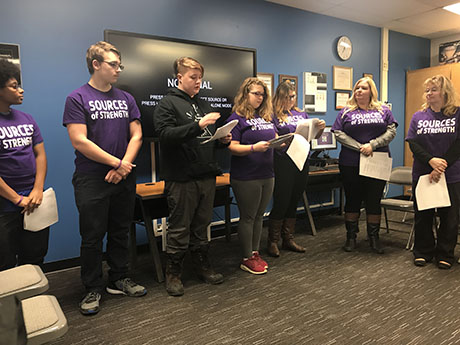
Sources of Strength is a suicide prevention program at Batavia High School that trains volunteer students to provide peer-to-peer assistance or help guide students who might otherwise be unwilling to talk with an adult to guide them to the right adult.
Currently, at Batavia HS, there are 10 adult advisers and 43 peer leaders.
Five of those peer leaders made a presentation about the program to the Board of Trustees Tuesday night.
The program also brings in campus speakers from Mental Health, GCASA, the Youth Bureau, and the YMCA.
Last month, peer leaders volunteered at the NYS Veterans Home, making Christmas cards with residents for armed service members overseas.
Training was provided by founders of the organization from Denver.
Students participating in the presentation Tuesday were Lily Whiting, AT Thatcher, Gavin Tucker, Stephanie Dibble, and Ben Best, with adult advisers Kelly Deneka and Heidi Meides.
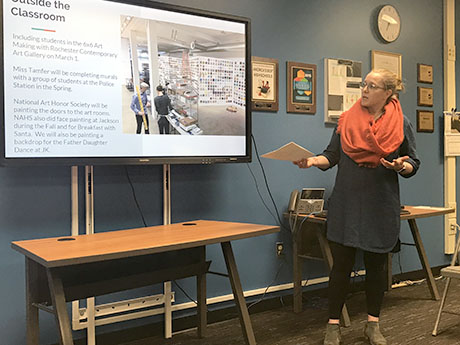
People really should attend the City School District's annual art show in March at the Richmond Memorial Library, Superintendent Chris Dailey said after art teacher Amanda Antonucci provided a department review Tuesday night at the Board of Trustees meeting.
"It's amazing what our kids produce," Dailey said.
This year the art show will feature a districtwide project: art students are drawing portraits of just their eyes. The pair of eyes will be displayed side-by-side on one long wall.
The opening night reception will be held March 15.
Antonucci went through several projects students are working on at schools in the district, including the fourth-annual monster swap project, where elementary students draw a monster and high school students make a sculpture of those monsters.
"It's my favorite project," Antonucci said.
Teachers at Jackson, John Kennedy, and the Middle School are all integrating STEM into their art instruction.
This includes learning about nature through art, using perspective to learn math and geometry, and science with Lego-related projects.
Dom Grazioplene is the most recent student selected for a solo art show at GO ART!, with an opening reception Thursday night.
There are art appreciation nights planned in May for Jackson and the high school and in May the middle school will host its annual human rights activists project.
Press release:
The Adult Educational Opportunity Center (AEOC) is visiting every Genesee Community College campus center in January to help any current or potential student through College Entry Point and FAFSA (Free Application for Federal Student Aid) Workshops.
The remaining events are listed below; any current or potential student can attend these workshops:
Batavia Campus -- 1 College Road, Batavia
Albion Campus Center -- 456 West Ave, Albion
Arcade Campus Center -- 25 Edward St., Arcade
Dansville Campus Center - 31 Clara Barton St., Dansville
Lima Campus Center -- 7285 Gale Road, Lima
Medina Campus Center -- 11470 Maple Ridge Road, Medina
The complete calendar of AEOC support workshops, financial aid sessions, College Entry Point events and more is available at www.genesee.edu/aeoc/.
One of the most popular workshops the AEOC offers are the "FAFSA Fests" (Free Application for Federal Student Aid). During these sessions, anyone can receive help in completing the FAFSA and TAP (Tuition Assistance Program) forms. Interested individuals are encouraged to contact the AEOC office at 1-888-394-2362 or via email at AEOC@genesee.edu to reserve a seat in any session and to learn about what information and materials are required for participation.
All of the AEOC services are free and available to anyone, not just students of Genesee Community College. With dozens of events taking place throughout the Genesee, Livingston, Orleans and Wyoming counties, the AEOC is readily available. For a complete list of AEOC workshop and other events, visit the new calendar of events online here.
To learn more about any of these AEOC services, please visit here or contact the AEOC office at 1-888-394-2362 or via email at AEOC@genesee.edu.

Pictured: Byron-Bergen students assist in unpacking the new equipment. Photo credit: Gretchen Spittler.
Submitted photo and press release:
This fall, the Byron-Bergen High School Science program was awarded a $25,000 America’s Farmers Grow Rural Education Grant. On Jan. 4, Agriculture teacher Jeffrey Parnapy received a delivery -- five modest shipping boxes containing $25,000 worth of state-of-the-art equipment to support the Agriculture, Biology, Chemistry and Physics programs.
"My colleagues and I are ready to implement these new tools directly into our coursework," Parnapy said. "We have been anticipating the arrival and it's very exciting to be able to bring a new level of technology to our students."
Parnapy wrote the grant proposal in collaboration with his science colleagues Michael Conine, Briana DelVecchio, Jenifer Faro, Peter Spence and Terry Vick.
This project was made possible by local farmers and America’s Farmers Grow Rural Education, sponsored by the Monsanto Fund.
The complete list of new equipment includes:
About America’s Farmers
The America’s Farmers campaign highlights the importance of modern U.S. Agriculture through communications and community outreach programs that partner with farmers to impact rural America. To learn more, visit America’s Farmers at www.AmericasFarmers.com.
About the Monsanto Fund
The Monsanto Fund, the philanthropic arm of the Monsanto Company, is a nonprofit dedicated to strengthening farm communities and the communities where Monsanto employees live and work.
Pembroke students Tuesday had a lot of questions for Astronaut David Saint-Jacques about being a space pioneer and life aboard the International Space Station.
Sixteen students were selected to ask questions and participating the planning of the event and today it all came together after months of preparation -- going back to April of last year -- during an assembly in the school's auditorium.
Saint-Jacques answered questions about what it was like to be in space, how his life inside the space station, what surprised him about going into space, and whether it was fun, along with addressing other topics.
Melissa Smith, a 7th and 8th-grade science teacher, took the lead on setting up the event and said it was a great opportunity to expose the students to things they may not otherwise get to do as part of their school experience. They learned about shortwave radio, the space station, about astronauts and they worked with members of the community to help bring it all together.
"We want to make a relatable experience for them so this was really cool because this isn't something we would necessarily teach in our curriculum, in our class, so it was a way we could go above and beyond what students normally learn," Smith said.
In all, 16 students were selected to ask questions during the eight or nine minutes the station was in position to connect via shortwave with a transmitter.
The ARISS event was managed by an international consortium of amateur radio organizations and space agencies including the National Aeronautics and Space Administration (NASA), Whitworth Ferguson Planetarium at SUNY Buffalo State, and members of the Genesee County Radio Amateurs (GRAM) Club. Pamela Ware, from Corfu, and member of GRAM, holds an FCC amateur extra license and was the liaison for the team of radio operators who provided hands-on training and experience for Pembroke students.
Press release:
St. Joseph School in Batavia announces its upcoming Open House and plans for National Catholic Schools Week 2019.
The theme this year is “Catholic Schools: Learn. Serve. Lead. Succeed.” The theme encompasses several concepts that are at the heart of a Catholic education. There is no better way to invest in a child’s future — or the future of our world.
St. Joe's is located at 2 Summit St. in the City of Batavia.
Sunday, Jan. 27th -- Open House
An Open House for prospective families will be held from 10 a.m. - 12 p.m. We will be kicking off the week with “The Great St. Joe’s Slime Off!” from 11 a.m. to 12 p.m. in the school cafeteria.
Monday, Jan. 28th -- Lunch and Bingo/Theme Day/The Great Kindness Challenge/ 8th Grade Robotics Tournament
Parents are invited to join their children for lunch and to play bingo afterward. Grades K-4 will enjoy lunch and play bingo from 11 a.m. - 12 p.m. and grades 5- 8 will follow from 12:15-1:15 p.m. We will be kicking off a kindness challenge with an assembly for all students at 8:30 a.m. in the cafeteria. The 8th grade will have a robotics competition at 1:30 p.m. in the gym. This will be a “theme dress-down day.” Each class will decide on a different theme.
Tuesday, Jan. 29th -- Movie at Batavia Showtime
We will be walking to Batavia Showtime to see a movie (TBD) at 9 a.m.
Wednesday, Jan. 30st -- Bowling/Ice Skating
Students in grades K-2 will be walking to Mancuso Bowling Center to bowl from 9 -11 a.m. Students in grades 3-5 will be walking to Mancuso Bowling Center to bowl from 11:30 a.m. - 1:30 p.m.
Students in grades 6-8 will walk to Falleti Ice Arena to skate from 11:30 a.m. - 1:30 p.m. A pizza lunch will be provided for all students before they leave.
Thursday, Jan. 31st -- House Activities/Pajama Day
Students will participate in a number of activities in their “houses” including Zumba, Minute to Win It games, technology challenges, team building activities, engineering projects, a scavenger hunt, and a kindness challenge. This is a non-uniform day and students may come to school dressed in their pajamas.
Friday, Feb. 1st -- 7 & 8 Grade Basketball Game/Jump Rope for Heart/Just Dance Craze
All grades will attend mass at 8:30 a.m. At 1 p.m. we will have our annual 7th and 8th grade exhibition basketball game in the gym. Students in grade 6 will be in attendance to cheer these students on. Grades 3-5 will have the choice to participate in a Just Dance Craze or attend the 7/8 grade basketball game. Grades Pre-K-2 will participate in Jump Rope for Heart (sponsored by the American Heart Association) activities in the cafeteria.
Please note: Grades 3-8 will participate in Jump Rope for Heart activities throughout the week. Donations are being collected in the cafeteria and the class with the most money raised will receive a prize.
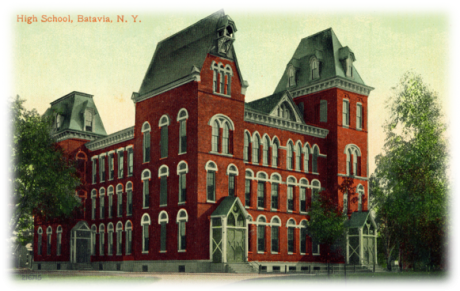
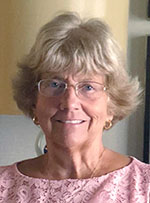
A couple of months ago a friend contacted me and asked if I would like a book from the Union School. I immediately said, “yes.” When I taught at Robert Morris School there was a painting of a very impressive red brick school called Union School. I always thought there was another school on Union Street besides Robert Morris. When I began researching schools for my book, I learned the impressive school did exist in Batavia but on Ross Street.
Here is a brief timeline of the schools in Batavia. As Western New York was settled in the 1700s, the first thing on a settler’s mind was to build a home for the family and gardens or crops to feed them, but no community was complete until a church was built and soon followed by a schoolhouse.
By 1798, there were 1,352 schools in the Holland Land Purchase (the area sold and administrated from the Holland Land Office in Batavia). Within 40 years (by 1838) that number increased almost tenfold, to 10,583.
The first brick school was constructed in Batavia in 1811. It had the public school downstairs and a meeting place for the Masonic Lodge upstairs. In 1829, the school district was divided between west of Dingle Alley and east of Dingle Alley. That would be the intersection of East Main and Center Street.
In 1839, the districts were consolidated and Batavia’s First Free Union School District 1 was built. In 1861, District 2 was combined with District 1. As a result, overcrowding occurred and the need for a new school was inevitable. The school district purchased land on Ross Street and in 1873 the red brick high school was built. It opened in 1874.
It was demolished in 1926 and was replaced with a new high school, currently the Batavia Middle School. The book I mentioned in this article was from the first high school that had the impressive red brick façade and towers. The book is stamped Union School 1905. The title of the book is, "The History of Little Goody Two Shoes," published in 1900. The book is dedicated "To All Young Gentlemen and Ladies who are good or intend to be good."
In 1911 the district was combined with one superintendent in charge of all schools. In the City School District, there was a high school, five elementary schools, the school for the blind and one Catholic school with students to 12th grade. By 1920, 400 students attended the high school; it was overflowing.
In 1921, 30 students had to go to vacant classrooms at East school. In 1920 the high school was built. There were five elementary schools and only one had been built in the 1900s. Washington was built in 1885 and had four rooms. In 1903 H. W. Homelius built a new school that had two floors and eight classrooms. It opened in 1904. Also built at the same time was Pringle School and William Street School. Washington School was built in 1885. East School and West School were built in 1892.
In 1925 Jackson School would be built to replace William School and Pringle School. In 1929 Brooklyn School, Robert Morris, and Jackson school opened. In 1939 Jackson School was enlarged and opened as a junior high school. By 1948 all city schools were crowded. Students were bussed to less crowded schools. Parents protested, they wanted their kids in their neighborhood schools.
Temporary schools were created at East School and Washington School. In 1950, city council offered to the City School District a site on Vine Street for a new school. Pringle school closed and was razed in 1954. Lincoln School closed in 1960. Children living south of Ellicott Street went to Jackson School, which was no longer a junior high school. A new school was to be built on Vine Street, called John Kennedy School, named after the superintendent John Kennedy who served from 1890 to 1930.
As public schools were being built, so were parochial schools. St. Joseph School opened in 1882, Sacred Heart School in 1904, St. Anthony’s School in 1930, St. Mary’s School in 1951, and Notre Dame High School opened in 1952. St. Joseph School is currently the only Catholic Elementary School in Batavia along with Notre Dame High School.
In 1961 the current Batavia High School was built on State Street. The high school on Ross Street was changed to a middle school. A new school for B.O.C.E.S. was also built on State Street and opened in 1976. In 1972 the new Genesee Community College was built.
In 2014 Robert Morris School closed. Jackson School became the district primary school and John Kennedy School became the intermediate school.
Even though the earliest history of the various schoolhouses throughout the region had similar stories with varied locations and different building designs, they all were built for the same reason -- to educate the children in what is today our city schools.
I attended East School, John Kennedy School, St. Joseph and Notre Dame High and I taught at Jackson School, Robert Morris School and John Kennedy School. I am currently on the faculty at St. Joseph School.
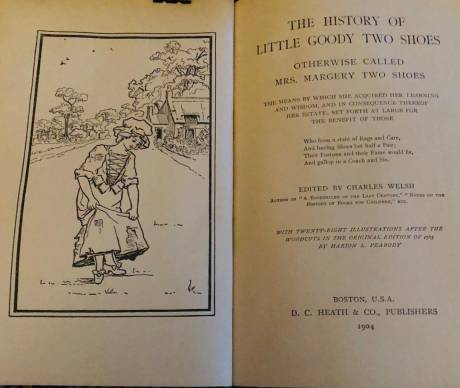
Press release:
In a rare and unique opportunity, several Pembroke students will make contact with astronauts on the International Space Station (ISS) via amateur radio.
Pembroke was one of only seven schools worldwide selected for this round of contacts, which is scheduled to take place on Tuesday, Jan. 8, at 10:28 a.m. in the auditorium of Pembroke Jr./Sr. High School in Corfu.
This activity is part of the Amateur Radio on the International Space Station Program (ARISS), which promotes learning opportunities as part of the Science, Technology, Education, and Math (STEM) initiative. This unique experience will provide an educational opportunity for Pembroke students to learn about wireless technology and radio science through amateur radio.
The ARISS event will be managed by an international consortium of amateur radio organizations and space agencies including the National Aeronautics and Space Administration (NASA), Whitworth Ferguson Planetarium at SUNY Buffalo State, and members of the Genesee County Radio Amateurs (GRAM) Club.
“This is a challenging and exciting opportunity for students to learn about space travel and exploration, how the astronauts live and work in space, and how students can – even at a young age – become radio amateurs for the emerging field of interplanetary communications,” said Melissa Payne Smith, a Science teacher at Pembroke’s Jr./Sr. High School.
Pamela Ware, Corfu resident and member of GRAM, holds an FCC amateur extra license and is the liaison for the team of radio operators who will provide hands-on training and experience for Pembroke students. She and Payne Smith – with the support of additional faculty, staff, and students at Pembroke – have spent several months coordinating their efforts in order to be chosen to speak with an astronaut at the International Space Station.
“From the minute Pam and I spoke, we believed that this would be an incredible opportunity for the students here at Pembroke," Smith said. "We spent hours planning, developing, and organizing our resources in the hopes of our school being selected. Multiple proposals were submitted, revised, and resubmitted during this process. It’s an honor for our school district to have been chosen for this."
Pembroke will continue to work with its partners to coordinate the exact date and time in January when students will be speaking with the International Space Station via amateur radio. In the weeks ahead, 20 Pembroke students will be chosen to participate in the transmission, and final technical preparations will take place.
This learning experience, multifaceted in academic and in real-world applications, has a much deeper meaning; students are learning that the sky, in fact, is not the limit.
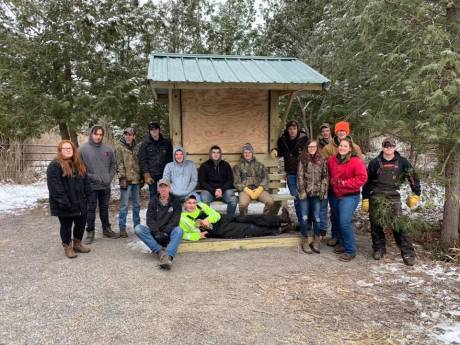
Press release:
Providing students with authentic learning experiences is the goal of every career and technical education program. Students in the Conservation Program at the Batavia Career and Technical Education Center got just that opportunity when they constructed a kiosk for the Town of Bergen.
Despite the rainy, cold weather and muddy grounds, the Conservation students built a kiosk that has a roof, two benches and an information board. This project can be found in the Town of Bergen’s Drew’s Nature Center, located on West Sweden Road.
Ernest Haywood is the supervisor for the Town of Bergen. He contacted Jon Sanfratello, executive principal of the Batavia Campus, which includes the Batavia Career and Technical Education Center, to inquire about the possibility of constructing the kiosk.
“I thought the opportunity to build a kiosk for the nature center would foster the students understanding and appreciation of our natural resources as well as provide students a real-life experience to build something that would benefit the community for years to come,” Haywood said.
“It is my hope that the kiosk will provide information for community members to enhance their knowledge of what the Drew's Nature Center has to offer and directions and guidance to visitors on how to independently explore, at one’s own pace, the natural wonders of the center.”
Sanfratello echoed Haywood's thoughts.
“This project gave the students the opportunity to understand the importance of time management, and customer satisfaction all while using the skills learned in the classroom and shop," Sanfratello said. "They worked under some difficult weather conditions but they got the job done."
Jacob Vandenbosch is the Conservation Program instructor.
“The Conservation students were able to learn carpentry skills by creating a location for the community to enjoy the outdoors. As an added bonus, they learned the importance of giving back to the community,” Vandenbosch said. “We will also be exploring future class projects at the nature center and working alongside the town to improve the community’s experience."
Submitted photo: The Conservation a.m. session class with their completed project. Not in order of photo. Ali Mann, Peyton Armison, Andrew Clark, Chad Green, Evan Hands, Mitchell Humel, Dominic Ianni, Kristofer Kuszlyk, Breanna Mest, Adam Offen, Noah Pangrazio, Tristan Rasmussen, Kaitlyn Shultz, Alec Slepinski, Nathan Tabor, Hunter Wade, Tyler Will.
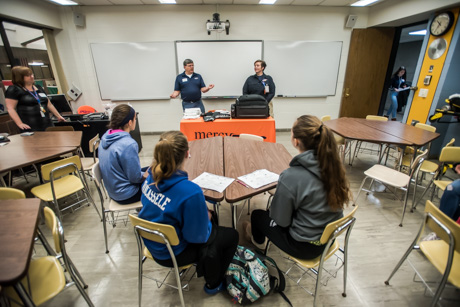
Terry Thompson and Becky Marsh, of Mercy Flight/Mercy EMS, talk about a career as a paramedic to a group of 10th-graders from throughout the region as part of the 10th Grade Career Day at Genesee Community College, sponsored by Batavia and Mount Morris CTE.
Throughout the morning, students rotated among a couple of dozen classrooms led by speakers from the local community representing various career fields including environmental science, cosmetology, educational administration, media and communications, the military, border protection, and nursing, among other fields.
More than 450 students from GLOW along with Steuben County participated.
Chris Suozzi, vice president of business development, Genesee County Economic Development Center, was the keynote speaker to kick things off in the morning.
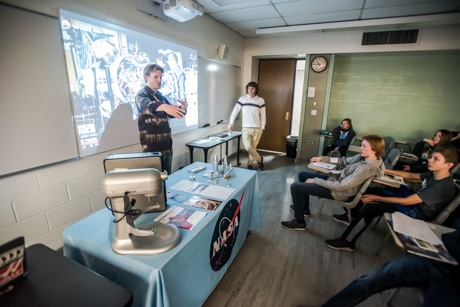
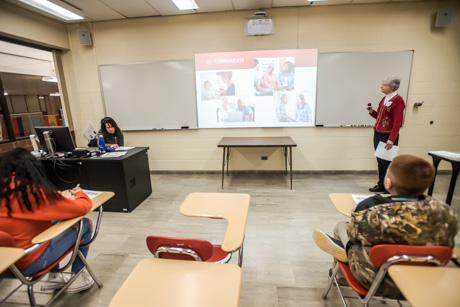
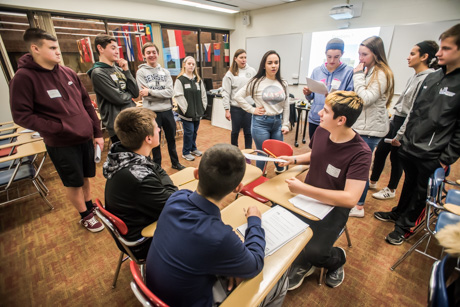

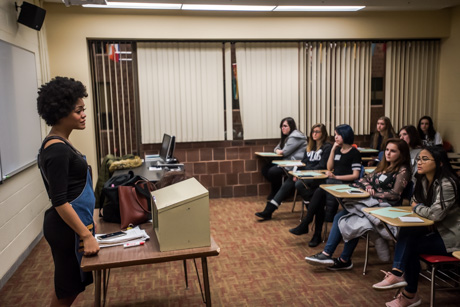
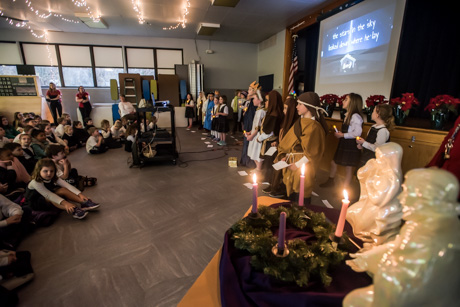
Students in Ann Marie Starowitz's class at St. Joe's performed a Christmas story play today for the third week of Advent that included students narrating the story of the birth of Jesus and singing Christmas songs for their fellow students.
Photos by Howard Owens. Bottom photo by Ann Marie Starowitz.
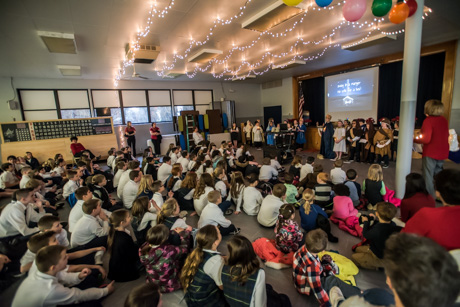

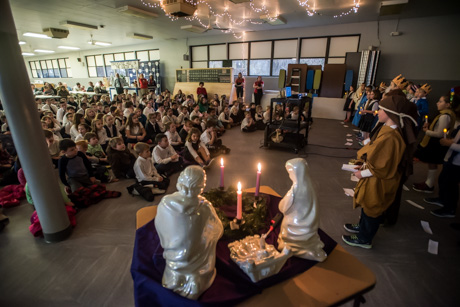
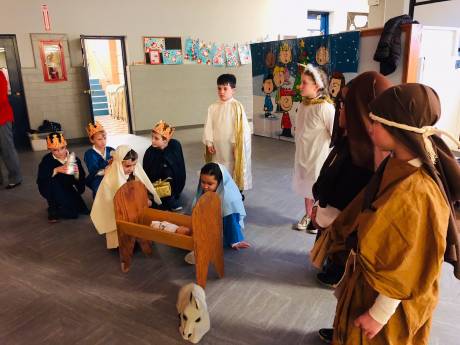
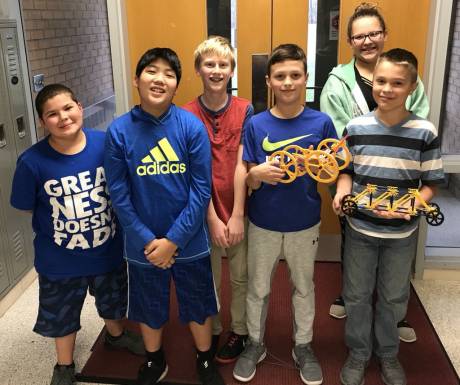
Byron-Bergen STEAM students, pictured from left: Logan Fregoe, Noah Clare, Adam Piper, Ian Pulcini, Kendall Pape and Carter Kuipers.
Submitted photos and press release:
On Nov. 9th, a team of Byron-Bergen STEAM students broke the world record currently posted on the Guinness website for distance traveled by a rubber-band-powered car.
Many people dream of joining the ranks of record-holders in the Guinness Book of World Records. Though most of these dreams go unrealized, Craig Schroth’s students are using engineering skills to earn Guinness recognition.
Schroth, a STEAM (Science, Technology, Engineering, Arts, and Mathematics) lab teacher at Byron-Bergen Elementary School, challenged his sixth-grade students to use simple machines -- a wheel and axle -- to build vehicles powered only by a wound up rubber band. Students used three class periods to methodically make changes and improve their designs.
“We moved the rubber band further forward,” explained sixth-grade student Adam Piper. “Then we added more rubber bands because the more we could wind it up, the further (the car) would go.”
In addition to the number of rubber bands, the design team added bigger wheels wrapped in rubber bands for increased road friction and elongated the distance between axles.
On Nov. 9, the team of Noah Clare, Logan Fregoe, Ian Pulcini, and Adam Piper broke the standing World Record with a run of 1,071 cm. According to the Guinness website, the current record for distance traveled by a rubber band car is 895 cm and was set on July 13, 2015.
“This STEAM design challenge not only involved real-world problem solving within the physical sciences, but it also included improving their design by collecting data through trial and error,” Schroth said. “Most groups were able to improve on their personal best of distance traveled by utilizing the engineering design process. All of the participating classes did a great job.”
Inspired by the sixth-grade success, the fifth-grade team of Carter Kuipers and Kendall Pape surpassed the previous winning distance by an additional 228 cm on Nov. 15, making 1,299 cm the longest distance achieved.
Schroth has contacted the Guinness organization to have the distances submitted for official approval. All of the participating students eagerly await a response.
Below: Adam Piper, Ian Pulcini, and Noah Clare prepare their rubber-band car for a test run.

Below: Sixth-grade team tests their rubber-band car in the hallway outside the STEAM lab.

Below: The fifth- (left) and sixth-grade (right) teams prepare to race head to head.

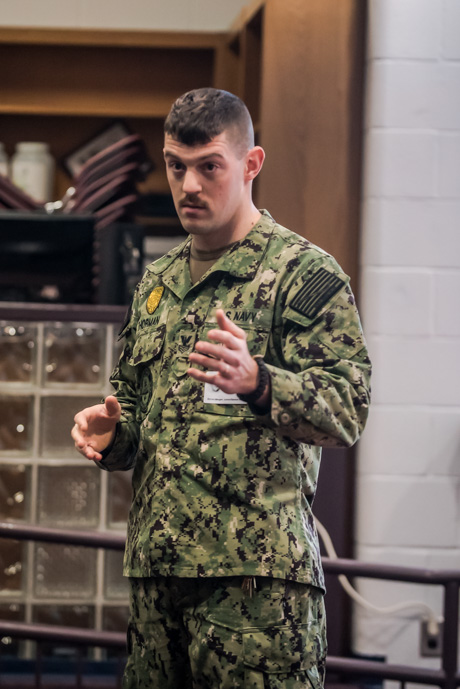
Keep moving forward, that is what Adam Thorman said he has done since graduating from Byron-Bergen High School more than 10 years ago and joining the Navy.
He's moved forward in his Navy career, from E-2 out of basic training to E-6 after 10 years of service. He's been recognized by his superiors for his hard work and dedication as a military security specialist. He's gotten married and become a father to a 17-month old daughter. And he has overcome tragedy in his family, the deaths in separate accidents of his twin sister and his younger sister.
He said he's moved forward with the help of friends and family but meeting his wife a couple of years after the deaths of his sisters in 2011 "kind of opened up my eyes that I could still move on while unfortunately still missing two of my family members," he said during a presentation Monday at the Western New York Tech Acadamy.
Thorman was one of four speakers for "Motivational Monday" at the academy. The other speakers were Gina Lathan from Lathan Construction, Jakob Terranova from Six Flags Darien Lake, and Kelley Yates from Sedgwick Business Interiors.
Thorman fielded a variety of questions from the three dozen students who attended the talks, including questions about his deployments overseas, his career plans, life in the military, and how he overcame obstacles (such as bringing his reading skills up to the necessary level to complete college) to advance his career.
"I really enjoy reading books now," he said.
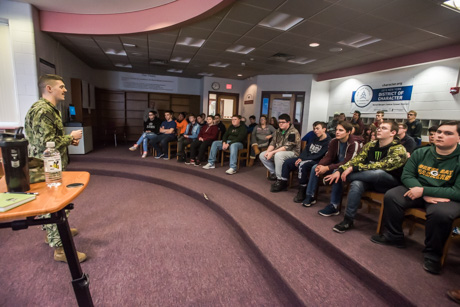
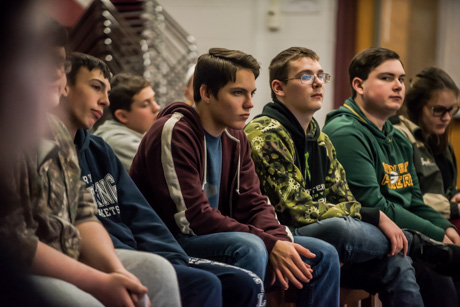
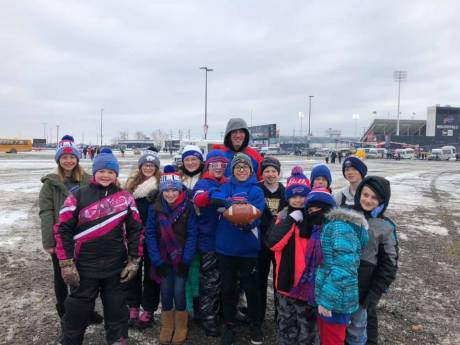
The Buffalo Bills' Lorenzo Alexander sponsored a reading contest at Pembroke Intermediate School for the month of October. Any student who completed a book during October would be entered to win one of 15 tickets to a Buffalo Bills football game.
Yesterday, 15 students attended the game, all-expenses paid by Alexander.
"It was a cold day, and despite the upset against the Jets these 15 students and teacher chaperones had the time of their life," said Melessa Cleveland, whose daughter, sixth-grader Angelina, was among the 15 winners. "A very special thanks to Lorenzo Alexander for donating food and tickets for yesterday's game."
Photos by Mr. Brown. Info and photos submitted by Melessa Cleveland.
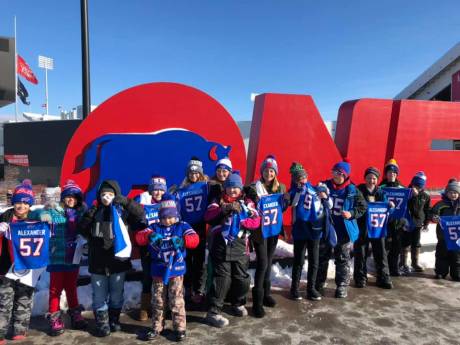
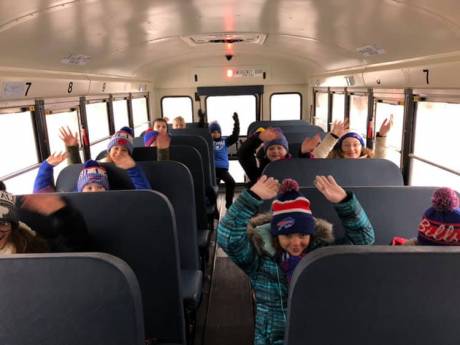
The Bionic Bees -- a team of third- through sixth-graders from the Gillam Grant Community Center -- won the Project Award at the Finger Lakes FIRST Lego League regional qualifier robotics competition.
On Saturday, Nov. 17 the Bionic Bees competed at The Integrated arts and Technology high school in Rochester against other area teams. This year’s theme for the competition was "Into Orbit." Teams had to think of a solution to a physical or emotional problem that astronauts face when in space for long periods of time.
The team’s solution was to use virtual reality to give astronauts pieces of home through sights, sounds and smells.
They designed Bionic Binoculars, which can give you the pleasant smells of their home. The motion-detecting gloves or controllers would set off a smell when placed near the accompanying visual. Astronauts could wear a vest with the binoculars that could adjust temperature depending on the setting like a fireplace for example. Through the viewer they could see and hear the familiar sights and sounds of home.
The team modeled their idea from the Oculus brand of virtual reality products.
FIRST LEGO League gives students the chance to develop, design, build and code LEGO MINDSTORMS robots to perform autonomous “missions” on a themed playing field and design innovative solutions to a real world problem inspired by the theme.
Along their journey, students develop critical thinking and team-building skills, basic STEM applications, and even presentation skills, as they must present their solutions with a dash of creativity to judges.
They also practice the Program’s Core Values, which emphasize discovery, teamwork and good sportsmanship. FIRST (For Inspiration and Recognition of Science and Technology) was founded in 1989 to inspire young people's interest and participation in science and technology.
Based in Manchester, NH, the 501(c)(3) not-for-profit public charity designs accessible, innovative programs that motivate young people to pursue education and career opportunities in science, technology, engineering, and math, while building self-confidence, knowledge, and life skills.
The Learning Center at Gillam Grant, a not-for-profit center located in Bergen. We provide tutoring, homework help and STEM (Science, Technology, Engineering, and Mathematics) enrichment classes and clubs for K-12thgrade students.
Copyright © 2008-2022 The Batavian. All Rights Reserved. Privacy Policy | Terms of Service